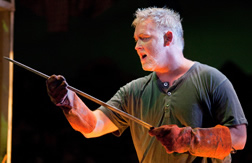The second concert of the Asheville Chamber Music Series, presented at Asheville’s Unitarian Universalist Church, featured six musicians from the Festival Pablo Casals Prades Collective.. In 1950 Casals founded a festival to celebrate the bicentennial of Bach’s death in Prades, a town in the south of France in the Pyrenees Mountains where the famed cellist resided in exile from Spain. The town has remained home to the festival, and, still going strong, is now under the artistic direction of Michel Lethiec, who was clarinetist in two of the evening’s works. Other musicians were violinists Kyoko Takezawa and Elina Vähälä, violist Nobuko Imai, cellist Arto Noras, and pianist Melvin Chen.
The concert opened with Darius Milhaud’s La Creation du Monde, a one-act ballet score which the composer arranged as a five-movement concert suite in 1927 (as Op. 81b) for piano quintet. For anyone who knows the original score with its colorful array of woodwinds, brass, and percussion, this version sounds very very much like a reduction. The homogeneous sounds of the strings, even with the piano in the mix, can in no way replicate the evocations of the other instruments, and what is really missing is the saxophone that plays the iconic opening melody. There were many beautiful moments, however. The outstanding movements in this performance were the dreamy Romance with its extended bluesy piano solo and the strongly etched rhythmic final movement.
Michel Lethiec next joined the string quartet for Mozart’s Clarinet Quintet, K.581. While Lethiec’s playing is masterful in every sense, the disappointment here was with the quartet, which failed to measure up to his high level of artistry. To be fair, the hall had been so warm and stuffy prior to the start of the concert that outside doors had been opened to cool things down before the ventilation system kicked in and made the temperature more comfortable. There were some intonation issues perhaps resulting from the temperature fluctuations, (in fact the piano was touched up during intermission), and I sensed that the string players played through the piece rather perfunctorily without really mining the beauty of Mozart’s score. Some of the momentum generated from the first movement Allegro spilled over into the second movement Larghetto, thus compromising the contemplative character of this hauntingly, beautiful arioso. The finest performance came in the fourth movement, a set of six variations, when it seemed the players finally allotted adequate attention to detail – the humorous third variation “viola lament,” the facile runs of the fourth, the deliciously savored slow tempo of the fifth with exquisitely controlled playing from Lethiec, and the smart and snappy finish.
Following intermission was Prokofiev’s Overture on Hebrew Themes, Op. 34, the only work on the program requiring all six members. This is extroverted, soul-filled music which the ensemble played to the hilt with an abundance of energy and humor. It was also a good programming choice to precede the lengthy Fauré Piano Quartet No. 1 in C minor, Op. 15, the final work on the concert.
For the Fauré, violinist Kyoko Takezawa joined forces with the violist, cellist, and pianist. As with the chamber music of Brahms, the piano was the dominating presence, and the musical and technical demands made on pianist Melvin Chen were considerable. Though writing for this small chamber medium, Fauré composed a work in which the big moments seemed to transcend its four players. The opening statement of movement one put the audience on notice that this is a big work permeated with large gestures and heightened emotions. All players dug into the score with a visceral connection and maintained a high level of performance throughout the mammoth dimensions of sheer length (four movements and nearly 30 minutes long), heavy technical demands, and intensity. I was particularly struck by the ease with which Chen navigated through the heavy demands of his part while carefully calibrating his voicing to suit each moment. Takezawa was also impressive with her impassioned interpretation. It was as exciting a performance as one might hear of this masterwork and brought the audience to its feet for a resounding ovation.
This series continues with the St. Lawrence String Quartet on November 16. For details, see our calendar.











